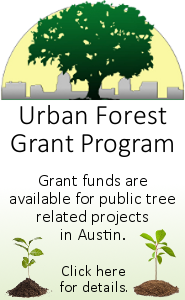The Austin Nature & Science Center offers a variety of educational science and art exhibits all year-round. Exhibits are open to the public during regular visitor hours with no entry fee, but donations are accepted. For more information, please call Visitor Services staff at 512-974-3888.

- Wildlife Exhibits
-
Learn about a wide variety of native wildlife in our outdoor and indoor exhibits. Meet the animals that call ANSC home and earn how you can help our animal ambassadors.
Visitors can meet and learn about a wide variety of amazing Texas wildlife here at the Austin Nature and Science Center. Some of these animals are former pets that have imprinted on humans and have not developed the proper skills needed to survive in the wild, while many others have sustained injuries or illness that prevent them from successfully returning to life in the wild. We partner with licensed rehabilitators to provide a permanent, safe, and comfortable home for the remainder of these animals' lives. Here we can provide them daily care, quality food, enriching experiences, and veterinary assistance that all promote optimal welfare while they serve as Animal Ambassadors for their species.
Wildlife Exhibits are open to the public during regular visitor hours.

Through a federal permitting system, we have the great privilege to provide homes to injured Central Texas birds. Many have suffered life changing injuries caused by hunting accidents and habitat degradation from urbanization. Here they can serve as animal educators, helping the public connect with and learn about their wild counterparts. Visitors get the rare opportunity to experience them up-close and learn how to coexist with these incredible birds of prey.

There are so many wonderful small creatures that call Austin home, and you will meet some of them here in the Small Wonders exhibit! These critters can all be found in the wild within 100 miles of Austin, and some of them can even be found right here at the Austin Nature & Science Center. Sometimes hidden, camouflaged, or just small enough to miss, here you can catch a glimpse of these special creatures and learn about their role in our ecosystem.

We are home to a variety of animals that can no longer live on their own in the wild. Many were imprinted on humans, orphaned, or injured and need our help to have a safe and healthy life. Here they receive dedicated daily care from our wildlife keepers. Visitors can learn all about Austin wildlife and how to respect them and their habitat by being good neighbors.
How to support our resident wildlife:
Monetary donations are always welcome!
When making a monetary donation please specify that it is for "ANSC Wildlife Supplies." Mail or drop off your donation to: Austin Nature & Science Center, 301 Nature Center Drive, Austin, TX 78746
Supply donations are always welcome!
We are always in need of supplies to support wildlife care. Donations of new (never used) items may be dropped off at the Visitor Pavilion during business hours. Receipt for donation available on request. See list below for most needed supply donations. For questions, please call 512-974-3894.
-
Food
Dry Dog Food (Purina adult maintenance)
Canned Cat Food (Purina ProPlan EN Gastroenteric)
Canned Cat Food (Friskies multi-flavors, HEB multi-flavors)
Timothy Rabbit Pellets (Mazuri, Oxbow, Kaytee)
Aquatic Turtle Food Sticks (Mazuri or Tetra ReptoMin)
Pigeon/Dove Seed (Mazuri, Hagen)
Wild Bird Seed Mixes (Wagner’s Deluxe Blend)
Tropical Fish Food Flakes (TetraMin)
Bloodworms (Frozen)
Meal Worms (bagged)
Super Worms (bagged)
Timothy Hay (bagged)
Red Wiggler Worms
Nightcrawlers
Consumables
REScue Disinfectant Cleaner & Deodorizer
Chlorhexidine Gluconate 2% (Durvet)
Distilled White Vinegar
Laundry Detergent (not HE type)
Dawn Dishwashing Liquid
SeaChem Prime Aquarium Water Conditioner
Dish Sponges
Dish Brushes/Scrubber
Supplies and Equipment
2’ x 4’ Plywood Sheets
2” x 4” Wood Beams
Carefresh Pet Bedding
Pine or Aspen Wood Shavings
Brown Butcher Paper Rolls
Pine Cones (bagged, unscented and not decorated)
Cypress Mulch (2 or 3 cubic foot bagged)
Organic Topsoil (2 or 3 cubic foot bagged)
Seashells (bagged, pre-cleaned)
Mini Ceramic Heat Emitter bulbs (150 W)
Mercury Vapor Bulbs - Arcadia D3EVO
50W Halogen Basking Spot Lamps
Small Mammal Chew Toys (gerbils/rabbits)
Naturalistic Reptile Water Bowls (various sizes)
Pet Food Bowls (stainless steel)
Heavy Duty Plastic Plant Saucers
Boomer Ball (10" -20” size of smaller)
Kong Toys (small or medium size)
Bird Toys
Rabbit Toys
Reptile Hides
Digital Kitchen Scale
Handheld Vacuum (cordless)
Towels (hand or bath sized)
Storage Containers (various sizes)
Aquarium Supplies:
- Gravel and Stones
- Air Pumps (battery powered or plug-in)
- Air Stones (with or without power supply)
- Algae Scrapers
- Glass Scrubbers
- Natural-looking Decorations
- Plastic Plant Decorations
Thank you for your donation and support!
-

- The Dino Pit
-
The Dino Pit is an outdoor paleontology exhibit, built for permanent display at the Austin Nature & Science Center (ANSC) located in Zilker Park. The project was developed and built through a collaborative effort of the ANSC, The University of Texas at Austin´s Texas Memorial Museum, the Austin Community Foundation, and the architectural firm of Graeber, Simmons & Cowen, which also served as project manager. The exhibit is designed to instruct visitors about paleontology through hands-on educational experience.
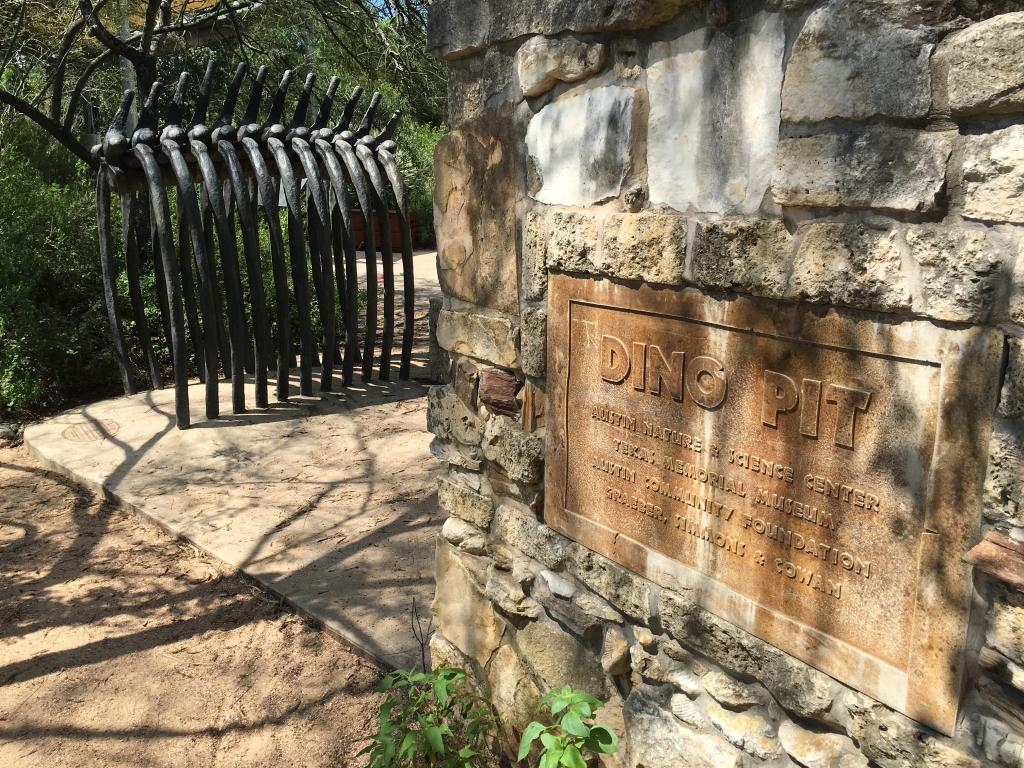
Artist John Maisano was instrumental in the development and completion of the Dino Pit project, working to transform a large area at ANSC into an educational dig site for finding fossil casts. Maisano modeled the casts using many of the important and unique specimens from the collections of the Texas Memorial Museum. He created an 8' x 6' mammoth rib cage cast in bronze, for the children’s entrance to the site, as well as 19 oil paintings depicting the creatures the children will find as they explore the pit.
Other features of the exhibit include dinosaur trackways, a field collection display that highlights fossils found at the 301 Congress Avenue construction site several years ago, and an observation deck. The exhibit is incorporated into the visitor programs currently offered at ANSC including youth programs, school field trips, camps, birthday parties, adult workshops and teacher training.
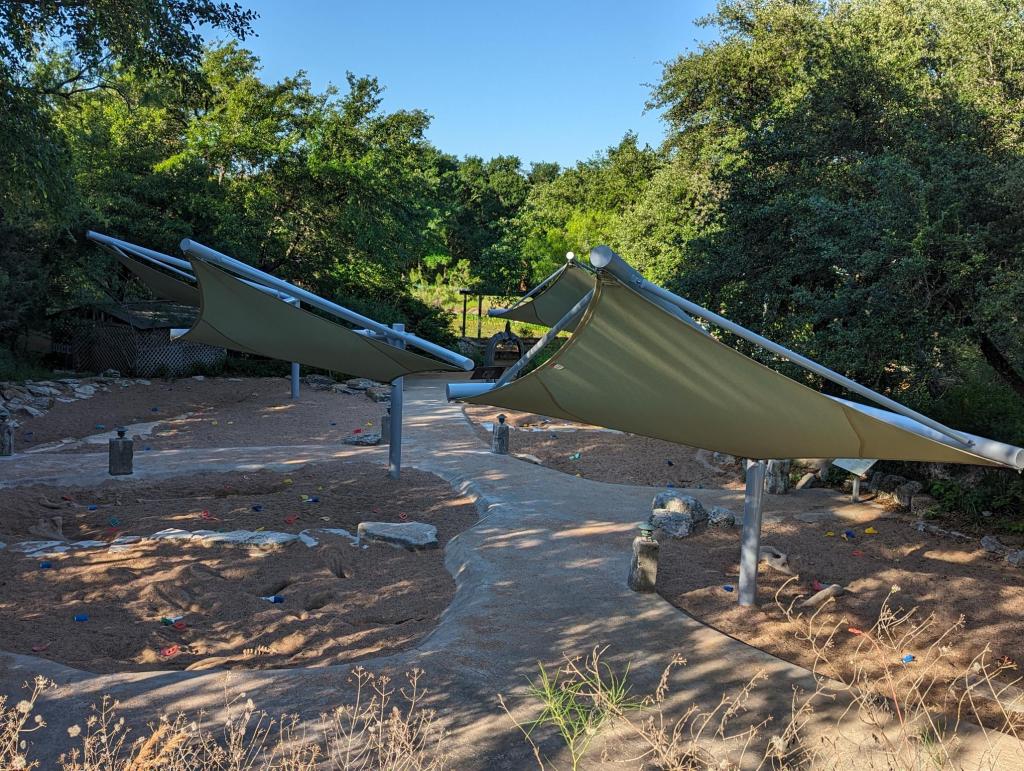
Exhibit Sponsors
Paleontologists Circle
- Ernest and Sarah Butler
- Natural Science Guild of Austin
- The City of Austin Parks and Recreation Department
- The University of Texas at Austin
Explorers Circle
- Ben and Joanie Bentzin
- Paul Koehler Brown
- The Webber Family Foundation
- Energy Engineering Associates
- H-E-B
- Texas Gas Service
Curators Circle
- Austin Commercial, LP
- The Kodosky Foundation
- Crescent Real Estate Equities
- Graeber, Simmons & Cowan
- Robert and Bettie Girling
- Austin Community Foundation
- Mattson-Mchale Family Foundation
- William and Bettye Nowlin
- Anne Elizabet and Will Wynn
Diggers Circle
- Austin Natural Science Association
Platinum Sponsors
- i2i
- Fugro
- Convergence Institute
- TBG Partners Baker-Aicklen & Associates, Inc.
Gold Sponsors
- McKinney Drilling
- Steel Design, Inc.
- Tri DalStephen and Stefani Griffith
- BAiley and Beverly Griffith
Silver Sponsors
- Capital Equipment
- Capital Aggregates
Bronze Gold Sponsors
- Texas Industrial Mechanical
- Bank of America
Support
- Austin Bridge and Road
- SBC Foundation
- Aaron Concrete
- Seasha Pools
- Barton Springs Nursery
- Capital City Steel
- TXI
- Take a virtual tour of the Dino Pit
-

- The Naturalist Workshop
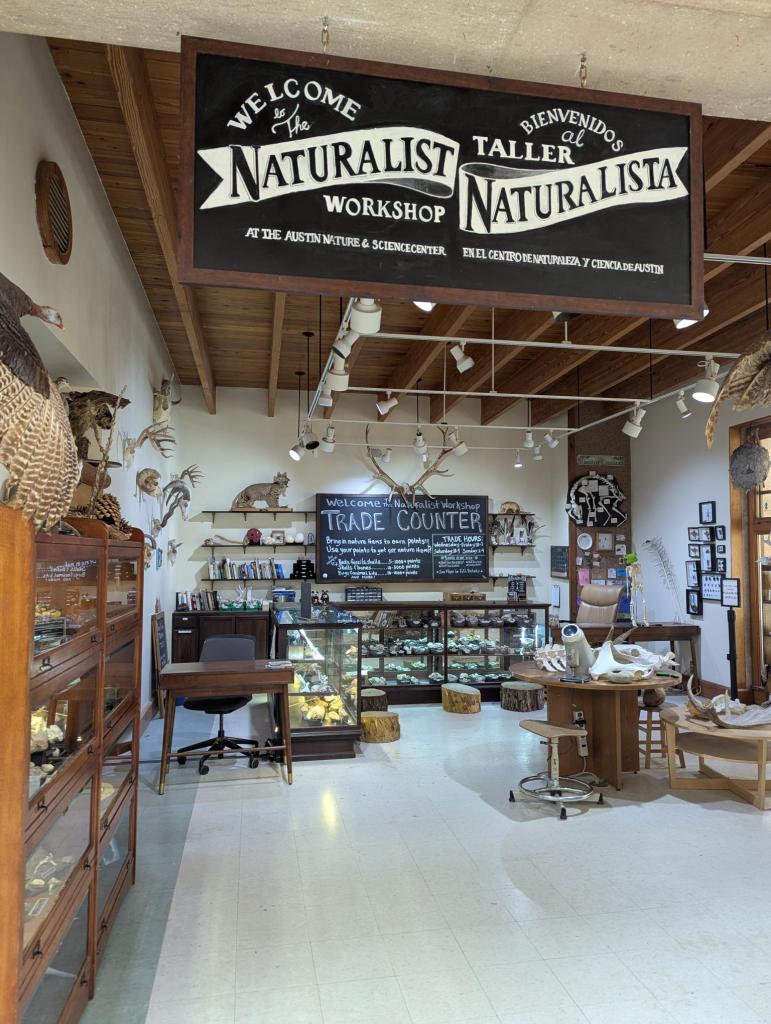
The Naturalist Workshop at the Austin Nature & Science Center is unlike most natural history museums you've visited. Here you are encouraged to touch, investigate, and learn about the many different collections we have on display. How much does a sugar pine cone weigh? Can you fit together a cow femur and pelvis? How many kinds of minerals can you see in one rock? Tables laden with rocks, minerals, fossils, bones, plants, insects, and more provide opportunities for all ages to get in touch with items straight from nature. Investigation tools and activities are available to help you learn more about what you see. Displays rotate so make sure you come back to see what new collections are out in the Naturalist Workshop.
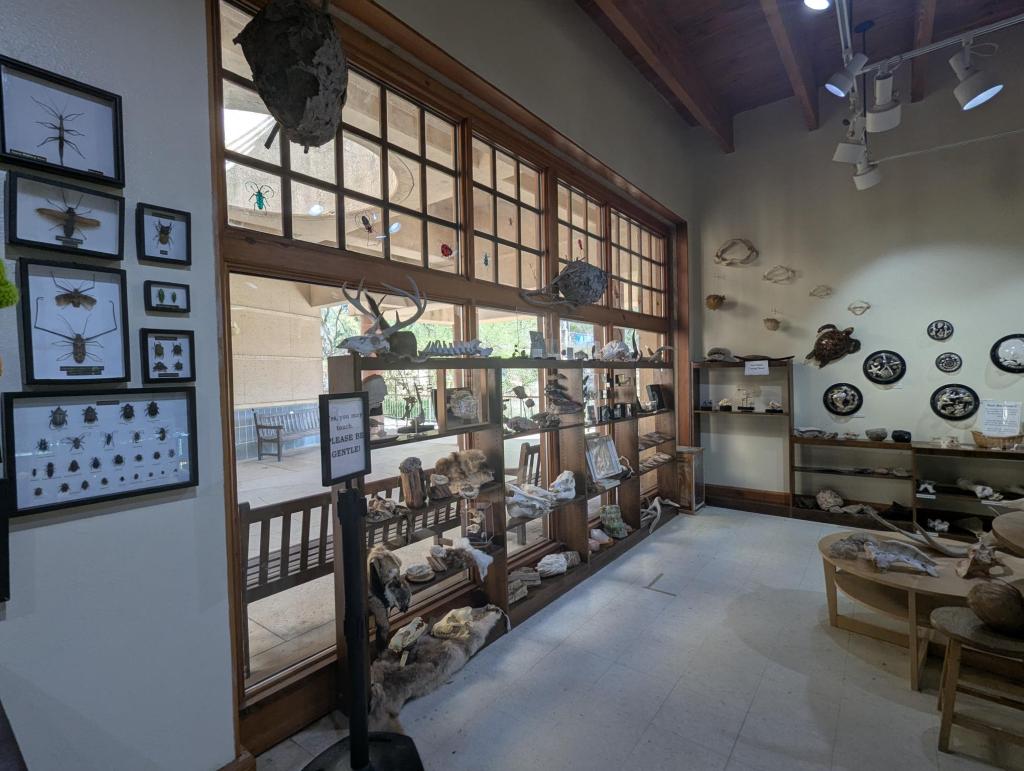
- The Trade Counter
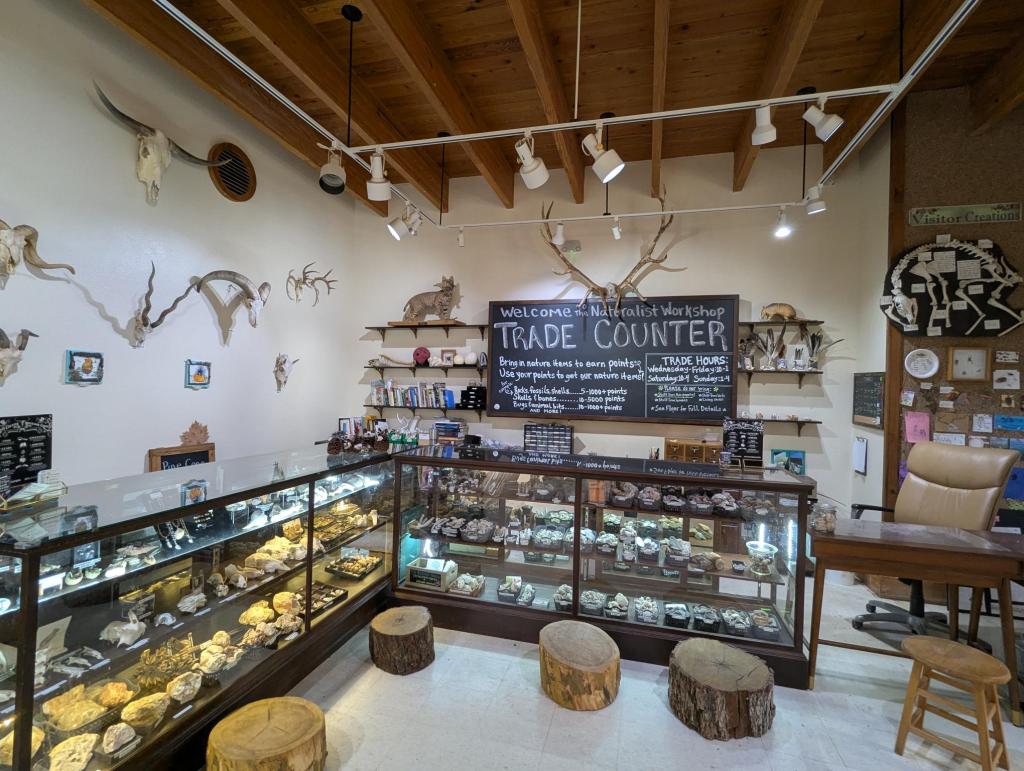
If you find yourself regularly discovering loose fossils, shells, rocks, or insect boxes clattering about in your washing machine, you or your loved one may be a naturalist.
The Trade Counter is where naturalists of all ages are welcome to sit down and share their discoveries with our Trade Counter volunteers, staff, and fellow nature enthusiasts. One can bring nature items, science reports, or scientific illustrations and art in exchange for points, which may then be used to buy a host of other things—rocks and minerals, fossils, insect collections, bones, shells, crafts, etc. For a list of what is accepted for trade at the Trade Counter please refer to the Trade Counter brochure
(PDF) or call 512-974-3888. Points may also be earned by reporting a nature sighting from the ANSC grounds, entries on iNaturalist (see following section) or for accomplishing the monthly puzzle (questions relating to one or more specimens, rotating monthly).
The Trade Counter is open:
Wednesday - Friday 10:00 AM - 1:00 PM
Saturday 10:00 AM - 4:00 PM
Sunday 1:00 PM - 4:00 PM
Trade counter Policies
Daily Trade Limit: Traders are limited to 5 unique objects per day.
Things we CANNOT accept:
- Anything from our site. We are a Nature Preserve and you cannot collect from preserves.
- Anything from birds. Many birds are under a variety of legal protections and are prohibited from being collected, so we discourage visitors from bringing any bird objects to trade. This protects us and our visitors.
- Anything from humans (including anthropological artifacts, such as arrowheads). Similar to birds there are many laws prohibiting the trade, sell, and collection of human artifacts.
- Anything purchased or endangered.
- Anything that was intentionally killed for bringing to trade.
Trade Counter Points System:
Categories
Scavenger Hunt__________________________________________________ 50
Scientific illustration or creative expression_____________________________ 20+
Marine & Invertebrate (shells, marine animals, etc.)______________________ 10+
Entomological (insects) ___________________________________________ 30+
Geological (rocks, minerals) _______________________________________ 10+
Botanical (plants) ________________________________________________ 10+
Paleontological (fossils) ___________________________________________ 10+
Zoological (any animal material including bones, fur, skin sheds, etc.)_______ 20+
Bonuses, awarded at the discretion of the Trade Counter Volunteer
Naturalist skills (collection, identification, description, etc.) ____________ 20 - 100+
Partial or broken specimen ____________________________________5 - 20+
Full Specimen______________________________________________ 10 - 100+
Rarity (general or particular to Texas) ___________________________ 5 – 500+
WOW factor_______________________________________________ 20 - 100+
This program exists in part through volunteer effort. If you are interested in volunteering, please visit the ANSC home page.
- iNaturalist
-
iNaturalist is a citizen science project and online social network of naturalists, biologists and citizen scientists built on the concept of mapping and sharing observations of biodiversity across the globe. The Austin Nature & Science Center's iNaturalist account is a place where our visitors, program participants and staff can share their observations of plants, animals, fungi, insects and more found on the ANSC's grounds and the adjoining Zilker Preserve. Entries can be shown to Trade Counter staff for points.

- The Forest Trail: Right Tree * Right Place * Right Reason
-
The Austin Nature & Science Center’s Forest Trail is a permanent self-guided exhibit that includes forty-five trees planted and maintained site-wide to encourage the selection of native trees appropriate for commercial and residential landscapes in Austin and Central Texas. The exhibit’s artistic signage, in English and Spanish, identifies each tree with a common name and scientific name, mature height, tree facts, and whether it is deciduous or evergreen.
The exhibit’s catch phrase, Right Tree * Right Place * Right Reason, serves as an easy reminder to do some research and ask some questions before selecting and investing in a tree to ensure a successful long-term outcome that costs less to maintain, gives confidence that the chosen tree will fulfill its intended purpose, and avoids unintended problems as it grows.
Choose the right tree by learning key facts about it. Consider why you are planting a tree and give thoughtful consideration to the tree’s role in the landscape along with what it will need to grow and thrive. Soil types, depth, and moisture content vary widely in this region and are a key factor in tree selection. Allow adequate room for the tree to grow to its natural height and width, considering proper spacing between trees and permanent elements like sidewalks, buildings, utilities in the ground and above, and aesthetics. A tree can live between fifteen and hundreds of years, depending on genus and species, so time spent considering these factors is well spent.
The exhibit’s theme and focus is encouraging people to choose and plant trees regionally native to Central Texas because they are well adapted to Austin’s local conditions, will sustain local wildlife, and are in keeping with its local identity. Wherever you live, please consider planting trees native to your location.
Why an Urban Forest is Vital
Austin’s urban forest—its tree canopy—is vital to water and air quality and helps mitigate the urban heat island effect. It’s a healthy and sustainable mix of trees, vegetation, and other components that comprise a contiguous and thriving ecosystem valued, protected, and cared for by the City and all of its citizens as an essential environmental, economic, and community asset.
Funding for the trail is generously provided by a City of Austin - Urban Forest Grant. The Urban Forest Grant (UFG) has been established to promote conservation and improvement projects that benefit Austin’s urban forest.
The Forest Trail Trees
- American Smoke Tree
-
American Smoke Tree (Cotinus obovatus)
- 6' - 12' (1.8m -- 3.7m)
- Large flower clusters resemble "smoke"
- Deciduous Caducifolio
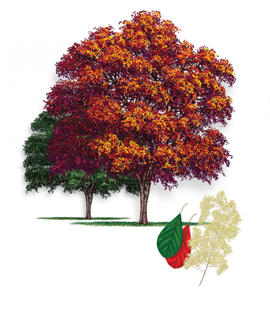
- Racimos de flares grandes que semejan ''humo''
Artwork © Robert O’Brien.
- American Sycamore
-
American Sycamore (Platanus occidentalis)
- 75' - 100' (22.9m - 30.5m)
- Tallest deciduous tree in the United States
- Deciduous Caducifolio
- 2nd generation "Moon Tree" from Apollo 14 Mission
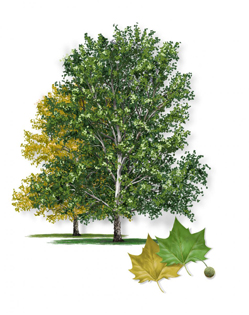
- Árbol caducifolio más alto en los Estados Unidos
- Generación "Arbol de la Luna" de la Misión Apollo 14
Artwork © Robert O’Brien
- Anacacho Orchid Tree
-
Anacacho Orchid Tree (Bauhinia lunarioides)
- 10' - 15' (3m - 4.6m)
- Unique foliage and showy white, sometimes pink, flowers
- Deciduous Caducifolio

- Follaje único con flores blancas vistosas, algunas veces rosas
Artwork © Robert O’Brien
- Anagua
-
Anaqua (Ehretia anacua)
- 25' - 40' (7.6m - 12.2m)
- Great source of nectar for pollinators and fruit for birds
- Semi-evergreen Semi-perennifolio
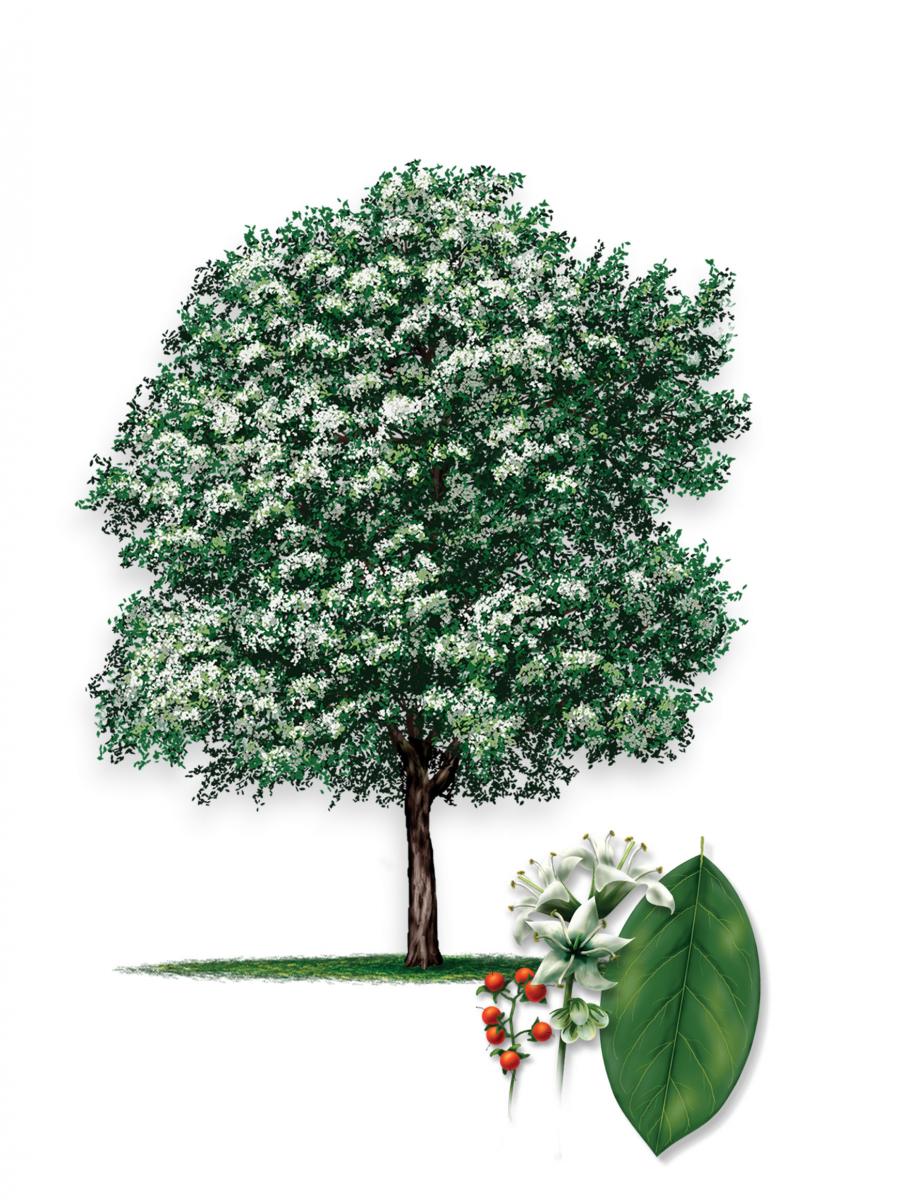
- Gran fuente de néctar para polinizadores y fruta para los pájaros
Artwork © Robert O’Brien
- Ashe Juniper
-
Ashe Juniper (Juniperus ashei)
- 25' - 35' (7.6m - 10.7m)
- High wildlife value; can be used for a windbreak and screening
- Evergreen Perennifolios
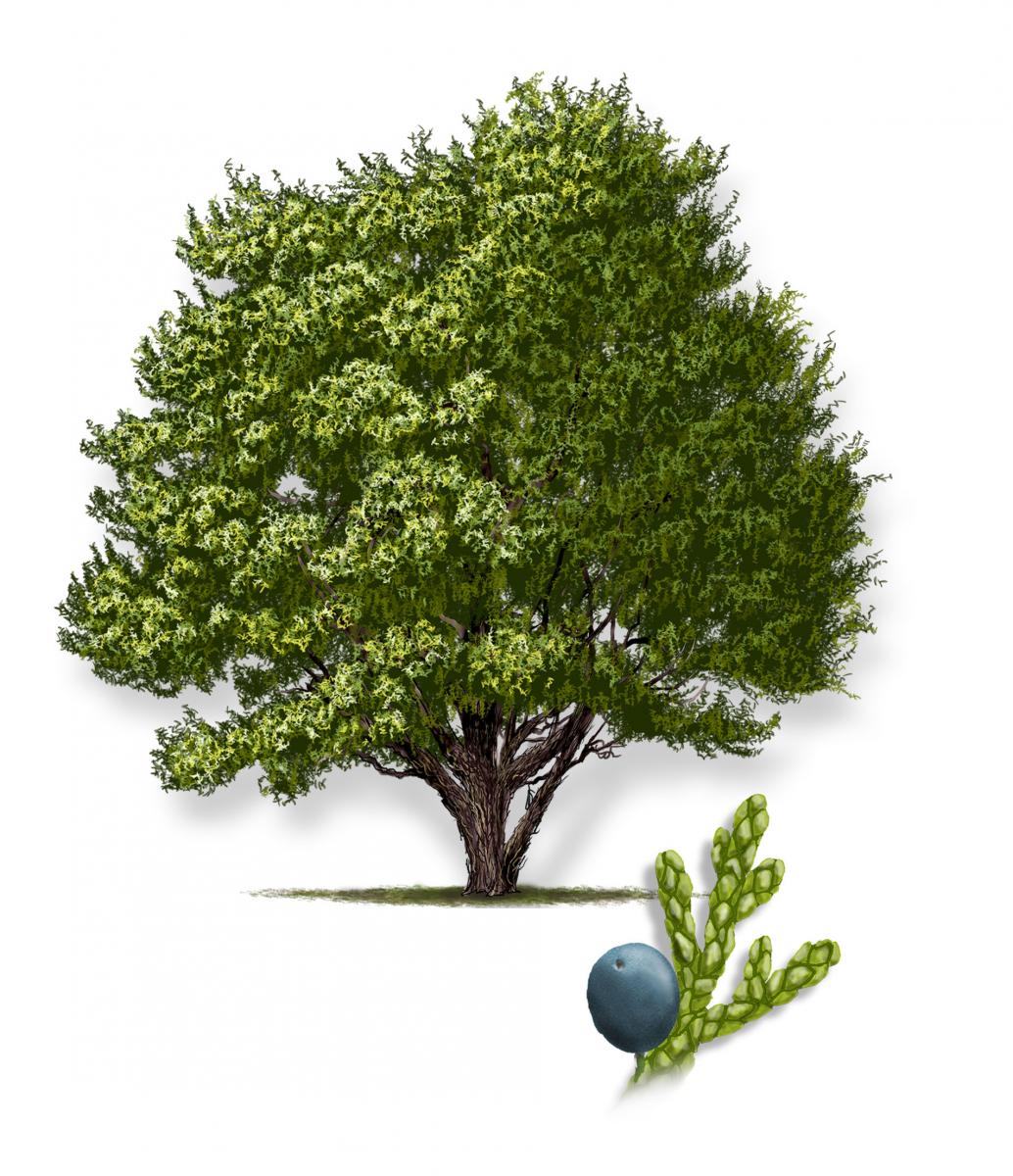
- Gran valor para la fauna silvestre
- Puede ser usado como rompe-vientos y protección
Artwork © Robert O’Brien
- Bald Cypress
-
Bald Cypress (Taxodium distichum)
- 75' - 100' (22. 9m - 30.5m)
- Conifer that thrives in moist, deep soils; known for their "knees" that are a special kind of root
- Deciduous Caducifolio
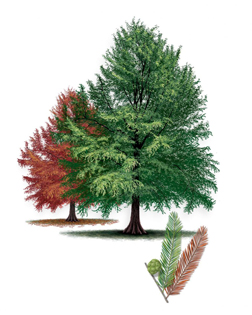
- Conífera que crece mucho en suelos húmedos, profundos
- Conocida por sus "rodillas"que son una raíz especial
Artwork © Robert O’Brien
- Bigtooth Maple
-
Bigtooth Maple (Acer grandidetatum)
- 25' - 45' (7.6m - 13.7m)
- Three to five-lobed leaves turn bright shades of red, gold, or orange in the fall
- Deciduous Caducifolio
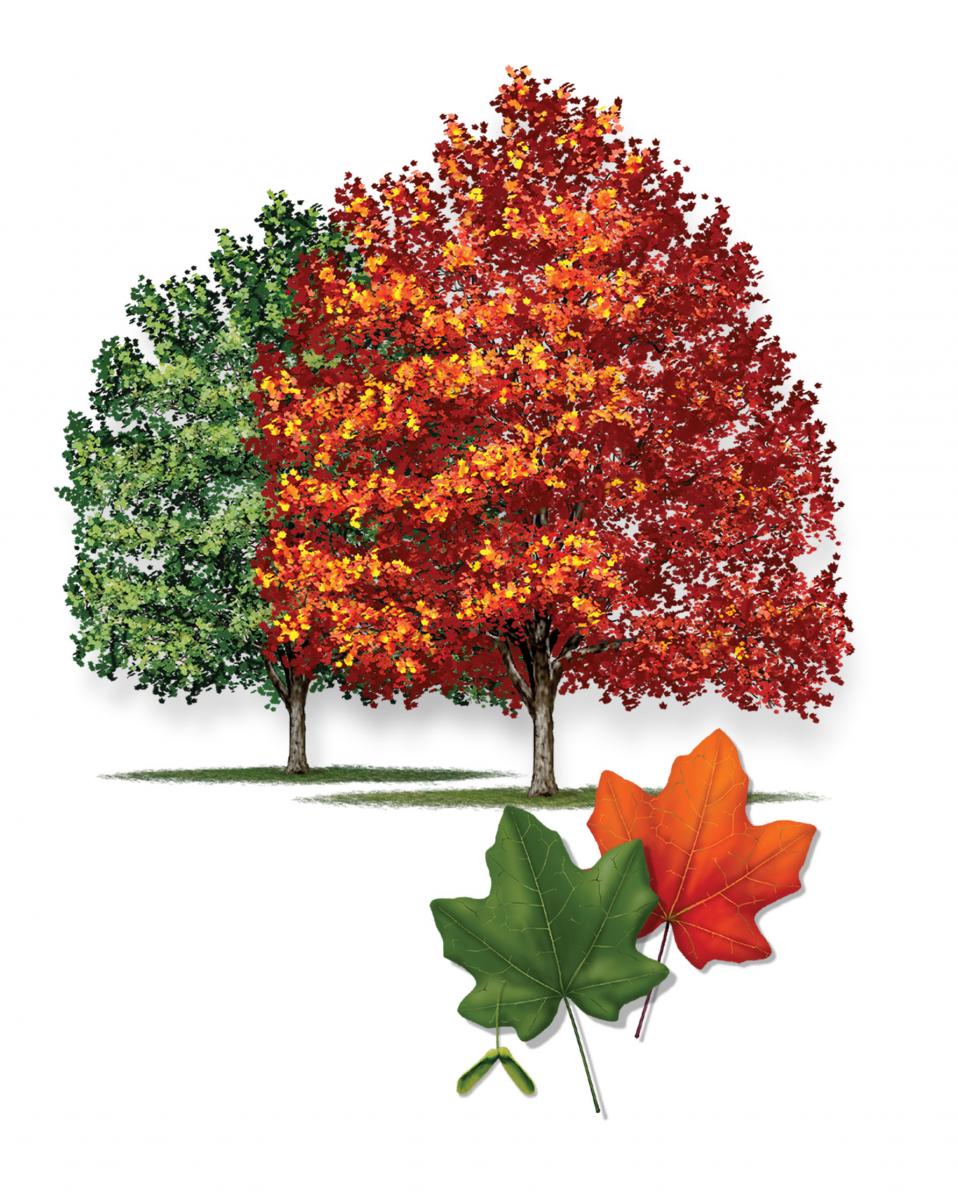
- Hojas con tres a cinco lóbulos que toman tonalidades brillantes de rojo, dorado o anaranjado en el otoño
Artwork © Robert O’Brien
- Blue Ice Arizona Cypress
-
Blue Ice Arizona Cypress (Hesperocyparis arizonica)
- 50' - 75' (15.2m - 22.8m)
- This cultivar sports intense, smoky blue foliage; makes a good windbreak or screen
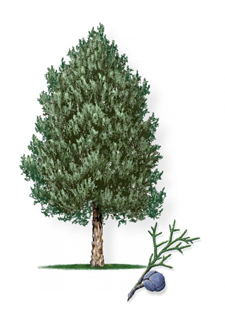
- Esta variedad de cultivo muestra un follaje azul, grisáceo
- Constituye un buen rompe-vientos o protección
Artwork © Robert O’Brien
- Bubba Desert Willow
-
Bubba Desert Willow (Chilopsis linearis)
- 15' - 25' (4.6m - 7.6m)
- This cultivar's large purple flowers attract pollinators; not a true willow.
- Deciduous Caducifolio
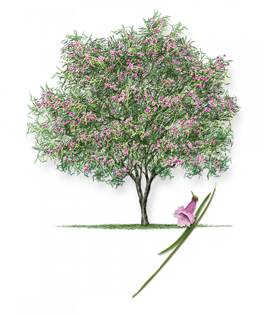
- Las flores grandes moradas de esta variedad cultivada atraen polinizadores
- No es un árbol de sauce en sí
Artwork © Robert O’Brien
- Bur Oak
-
Bur Oak, (Quercus macrocarpa)
- 50' - 75' (15.2m - 22.9m)
- Largest acorn of all oaks
- Deciduous Caducifolio
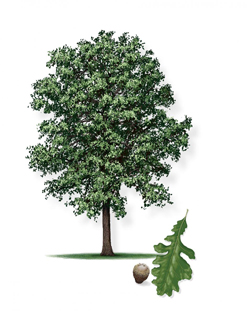
- La bellota más grande de todos los robles
Artwork © Robert O’Brien
- Caroline Buckthorn
-
Carolina Buckthorn (Frangula caroliniana)
- 6' - 12' (1.8m - 3.7m)
- Showy small tree with glossy foliage; berries for wildlife
- Deciduous Caducifolio
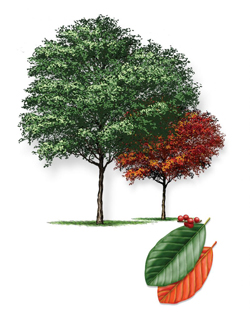
- Pequeño árbol vistoso con follaje brillante
- Frutas del bosque para la vida salvaje
Artwork © Robert O’Brien
- Cedar Elm
-
Cedar Elm (UImus crassifolia)
- 50' - 70' (15.2m - 21.3m)
- Adapted to a variety of landscape conditions; yellow fall color
- Deciduous Caducifolio
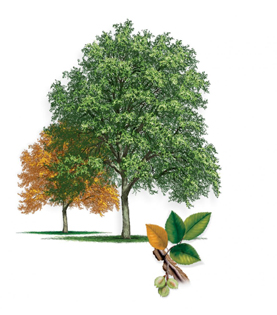
- Adaptado a una variedad de condiciones del bosque
- Color amarillo en el otoño
Artwork © Robert O’Brien
- Chinkapin Oak
-
Chinkapin Oak (Quercus muehlenbergii)
- 40' - 50' (12.2m - 15.2m)
- Excellent shade tree adapted to limestone soils
- Deciduous Caducifolio
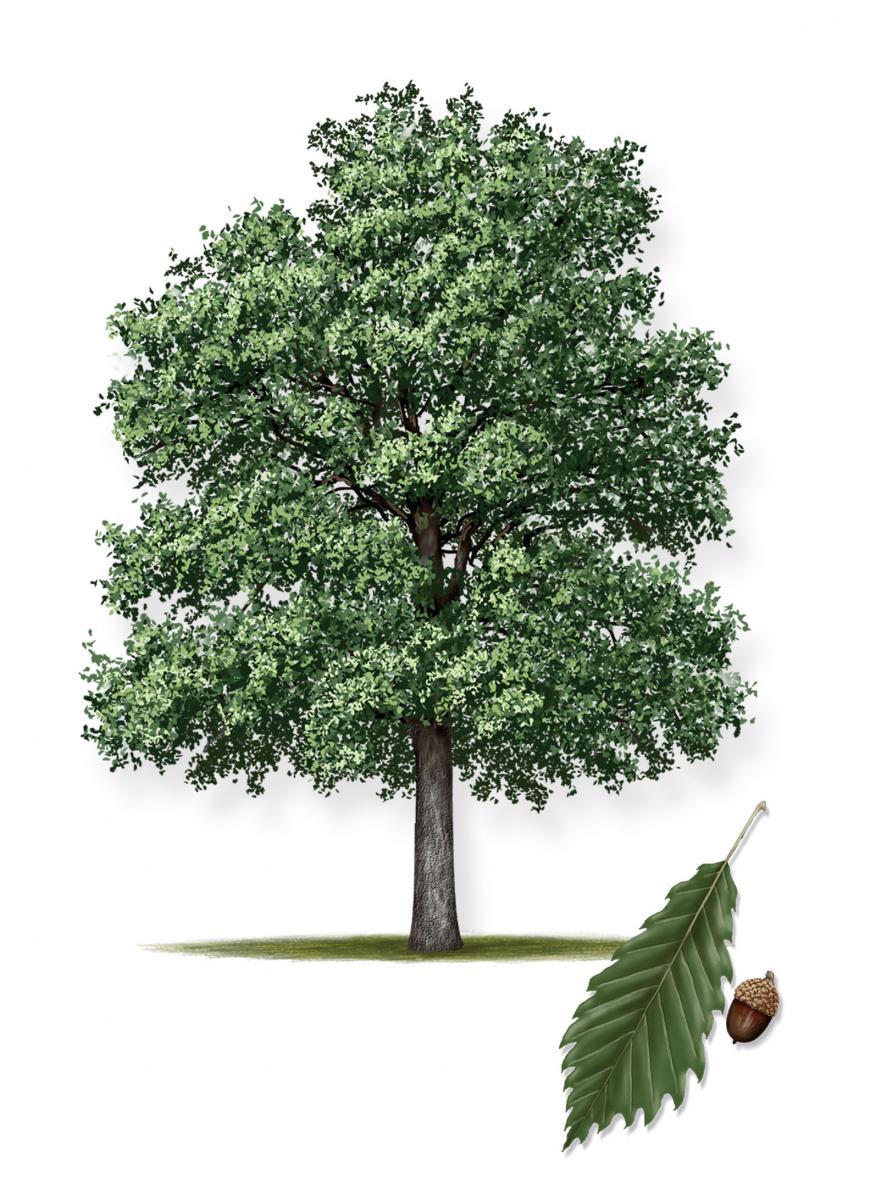
- Excelente árbol para proporcionar sombra adaptado a los suelos de piedra caliza
Artwork © Robert O’Brien
- Common Hackberry
-
Common Hackberry (Celtis occidentalis)
- 25' - 75' (7.6m - 22. 9m)
- Rarely planted but often present; high wildlife value
- Deciduous Caducifolio
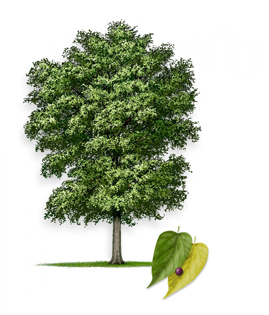
- Rara vez plantado pero presente muy a menudo
- Gran valor para la fauna silvestre
Artwork © Robert O’Brien
- Eastern Cottonwood
-
Eastern Cottonwood (Populus deltoides)
- 65' - 100' (21.3m - 27.4m)
- Fast growing and short lived; best planted in a large rural landscape
- Deciduous Caducifolio
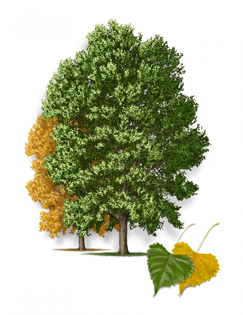
- De rápido crecimiento pero de vida corta
- Es mejor plantado en un área o entorno rural grande
Artwork © Robert O’Brien
- Escarpment Black Cherry
-
Escarpment Black Cherry (Prunus serotina var. eximia)
- 20' - 35' (6.1m - 10.7m)
- High wildlife value; attracts pollinators
- Deciduous Caducifolio
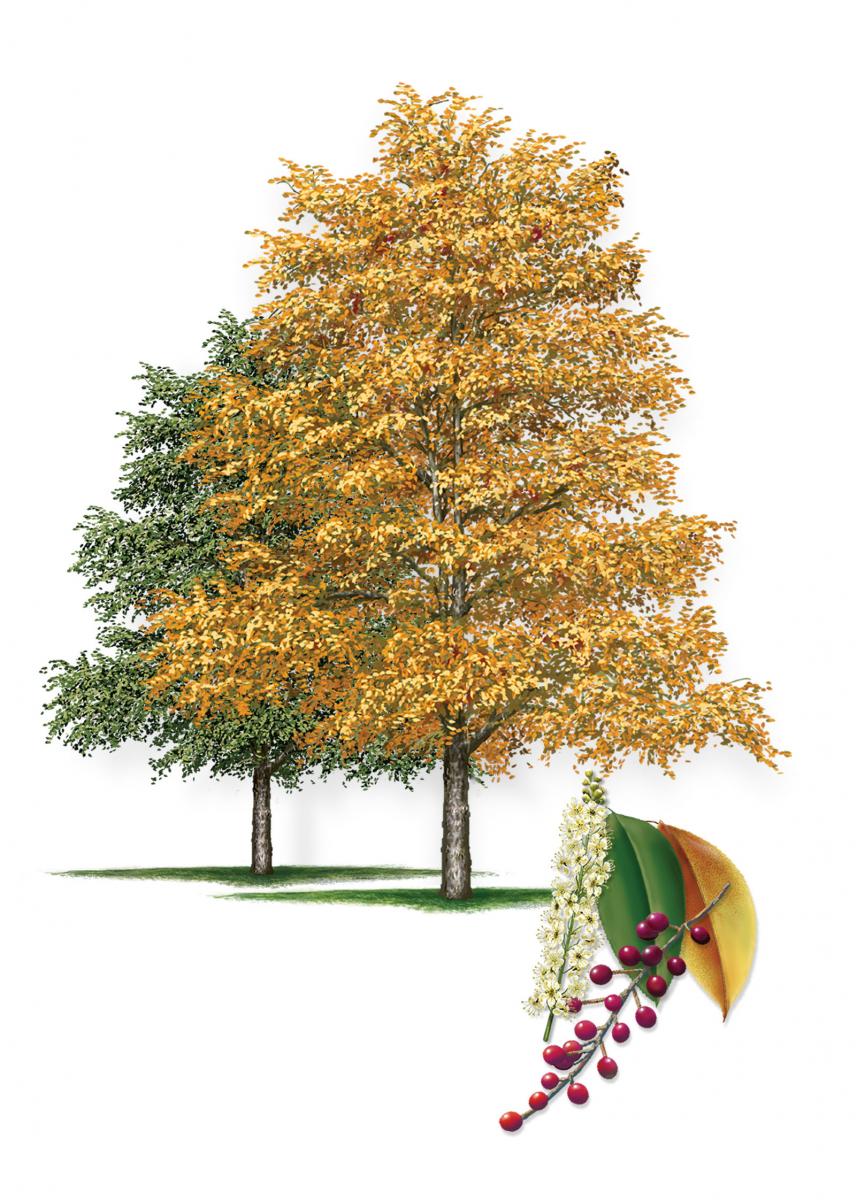
- Gran valor para la fauna silvestre
- Atrae polinizadores
Artwork © Robert O’Brien
- Escarpment Live Oak
-
Escarpment Live Oak (Quercus fusiformis)
- 35' - 65' (10.7m - 19.8m)
- Popular oak that is smaller than Q. virginiana; better fit for home landscapes
- Evergreen Perennifolios
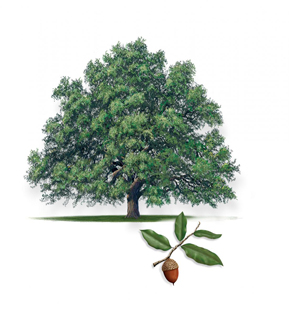
- Roble popular menor al Q. virginiana
- Más adecuado para jardines caseros
Artwork © Robert O’Brien
- Eve’s Necklace
-
Eve's Necklace (Stryphnolobium affine)
- 15' - 25' (4.6m - 7.6m).
- Lovely pink spring blooms followed by interesting seed pods
- Deciduous Caducifolio
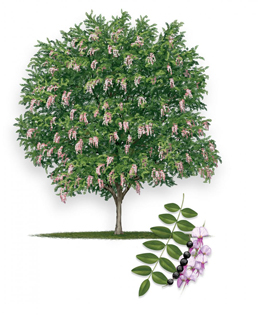
- Bonitas flores rosas durante la p·rimavera, seguidas por vainas de semillas interesantes
Artwork © Robert O’Brien
- Goldenball Leadtree
-
Goldenball Leadtree (Leucaena retusa)
- 15' - 20' (4.6m - 6.1m)
- Fragrant yellow puffball flowers throughout the growing season
- Deciduous Caducifolio
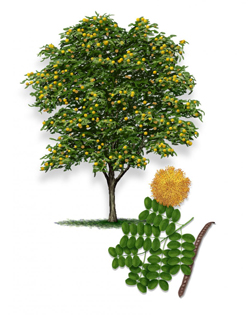
- Flores en forma de bolas de algodón fragantes de color amarillo durante la temporada de crecimiento
Artwork © Robert O’Brien
- Honey Mesquite
-
Honey Mesquite (Prosopis glandulosa)
- 25' - 35' (7.6m - 10.7m)
- Heat and drought tolerant; thornless selection available
- Deciduous Caducifolio
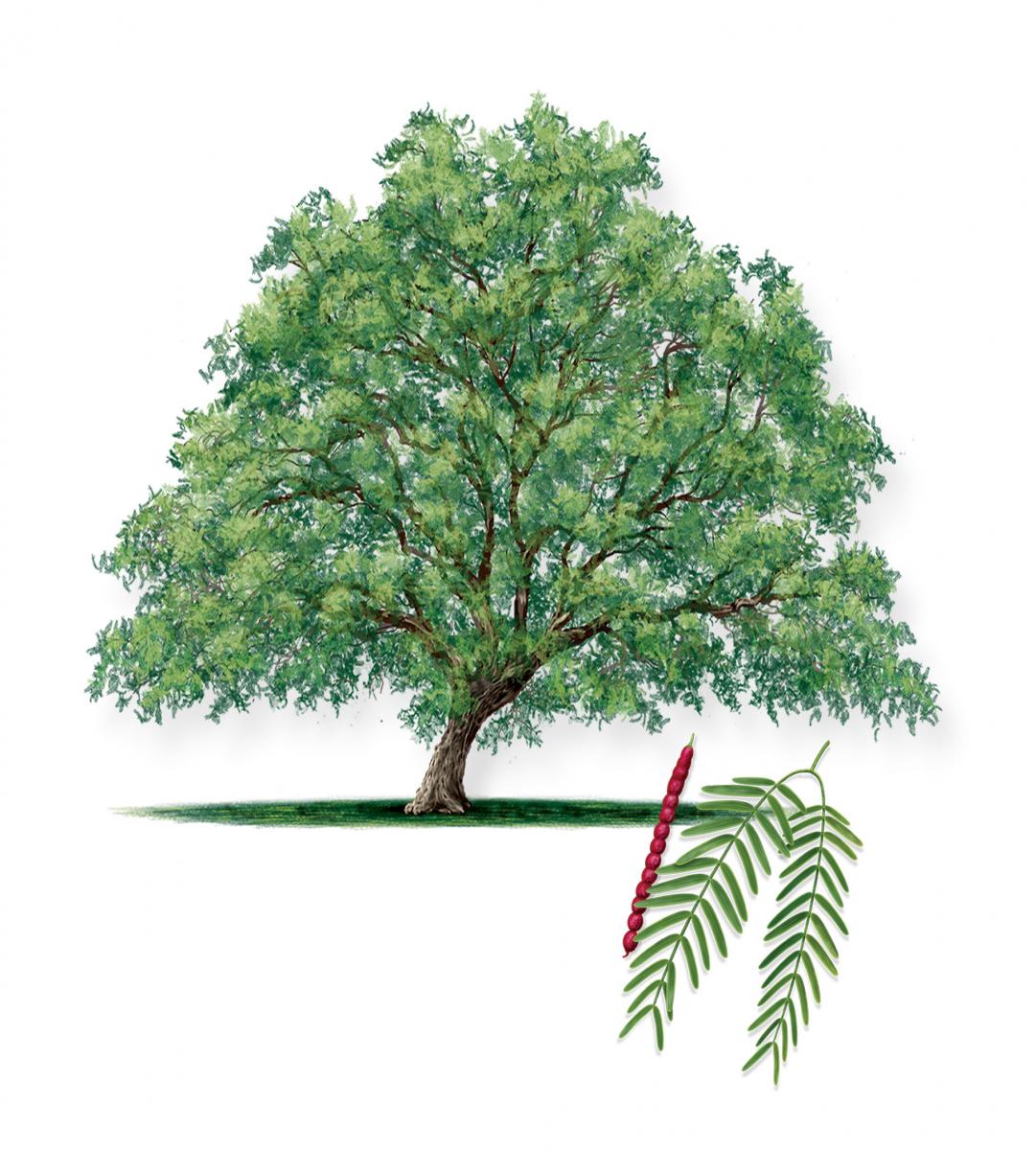
- Tolera el calor y la sequía
- Existe una selección sin espinas
Artwork © Robert O’Brien
- Huisache
-
Huisache (Vachellia farnesiana)
- 20' - 35' (6.1m - 10.7m)
- Fragrant yellow spring flower clusters; a source of perfume since the 19th century
- Deciduous Caducifolio
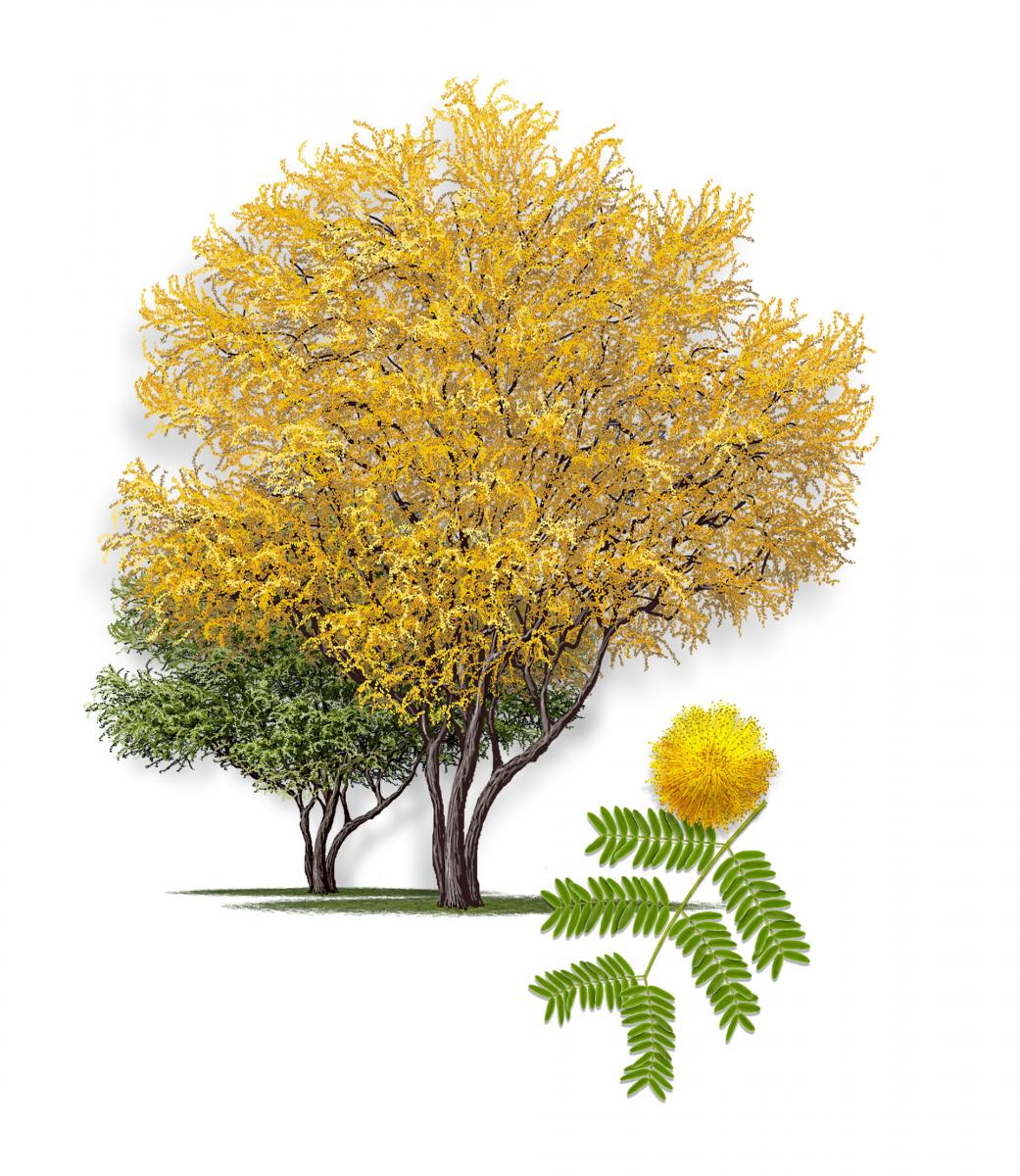
- Racimos de flores fragantes de color amarillo durante la primavera
- Una fuente para fabricar perfume desde el Siglo 19
Artwork © Robert O’Brien
- Lacey Oak
-
Lacey Oak (Quercus laceyi)
- 15' - 25' (4.6m - 7.6m)
- Summer foliage takes on a bluish smokey appearance
- Deciduous Caducifolio
.jpg)
- El follaje durante el verano cambia a una apariencia azul grisácea
Artwork © Robert O’Brien
- Little Gem Southern Magnolia
-
Little Gem Southern Magnolia (Magnolia grandiflora)
- 15' - 25' (4.6m - 7.6m)
- Dwarf cultivar with a dense pyramid shape; fragrant large white flowers
- Evergreen Perennifolios
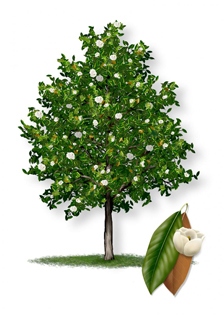
- Variedad enana cultivada con una forma de pirámide densa
- Flores blancas grandes y fragantes
Artwork © Robert O’Brien
- Mexican Buckeye
-
Mexican Buckeye (Ungnadia speciosa)
- 12' - 20' (3.7m - 6.1m)
- Not a true buckeye, but has similar large seeds; showy pink spring blooms
- Deciduous Caducifolio
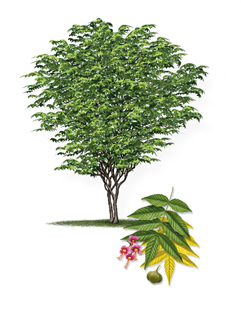
- No un castaño de indias en sí, pero tiene semillas grandes similares
- Flores rosas vistosas durante la primavera
Artwork © Robert O’Brien
- Mexican Pistachio
-
Mexican Pistachio (Pistacia mexicana)
- 12' - 20' (3.7m - 6.1m)
- Ornamental tree with white spring blooms and showy red growth
- Evergreen Perennifolios
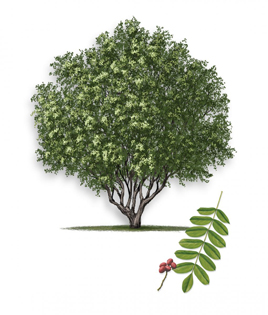
- Árbol ornamental con flores blancas en la primavera y que crecen hasta mostrar un color rojizo vistaoso
Artwork © Robert O’Brien
- Mexican Plum
-
MEXICAN PLUM Mexican Plum (Prunus mexicana)
- 15' - 25' (4.6m - 7.6m)
- Fragrant white flowers in early spring; provides tasty fruit
- Deciduous Caducifolio
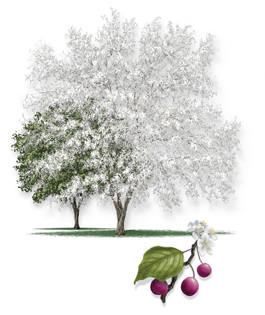
- Flores blancas fragantes al inicio de la primavera
- Da una fruta de sabot agradable
Artwork © Robert O’Brien
- Mexican Redbud
-
Mexican Redbud (Cercis canadensis var. mexicana)
- 15' - 20' (4.6m - 6.1m)
- More drought tolerant than other reginal redbuds with smaller, glossy, wavy-edged leaves
- Deciduous Caducifolio
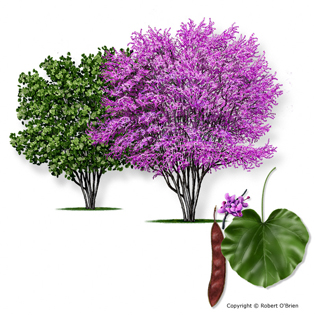
- Tolera la sequía más que otros árboles de ciclamor con hojas más pequeñas, brillantes y con orillas onduladas
Artwork © Robert O’Brien
- Mexican White Oak
-
Mexican White Oak (Quercus polymorpha)
- 30' - 40' (9.1m - 12.2m)
- Adapted to a variety of landscape conditions; resistant to Oak Wilt disease
- Semi-evergreen Semi-perennifolio
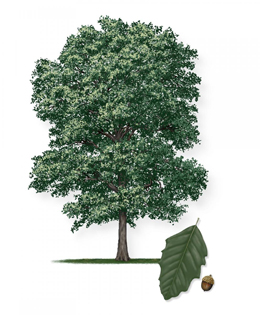
- Adaptado a una variedad de condiciones de paisajismo
- Resistente a la enfermedad llamada "Oak Wilt"
Artwork © Robert O’Brien
- Montezuma Bald Cypress
-
Montezuma Bald Cypress (Taxodium mucronatum)
- Unlike·bald cypress, does not produce root "knees"
- 45' - 70' (13.7m - 21.3m)
- Evergreen Perennifolios
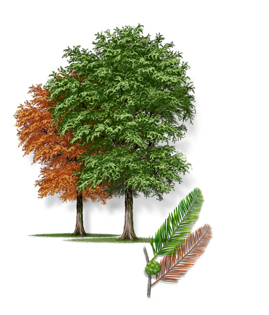
- A diferencia del ciprés de los pantanos
- No produce raíces en forma de "rodillas"
Artwork © Robert O’Brien
- Oklahoma Redbud
-
Oklahoma Redbud (Cercis canadensis var. texensis 'Oklahoma')
- 15' - 25' (6.1m - 4.6m)
- This cultivar sports darker pink flowers; vigorous, healthy growth habit
- Deciduous Caducifolio
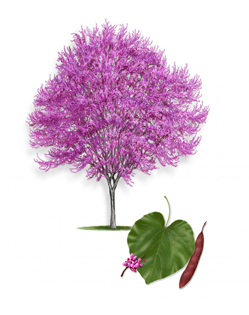
- Esta variedad de cultivo muestra flores rosas de color obscuro
- Con un hábito de crecimiento sano y vigoroso
Artwork © Robert O’Brien
- Pecan
-
Pecan (Carya illinoinensis)
- 50' - 75' (15.2m - 22.9m)
- State Tree of Texas with tasty fruit and high wildlife value
- Deciduous Caducifolio
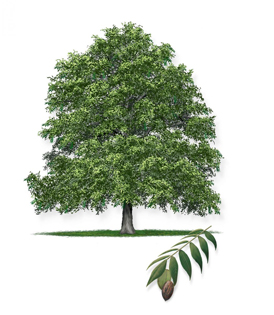
- El árbol del Estado de Texas con fruta de sabot agradable y de gran valor para la fauna silvestre
Artwork © Robert O’Brien
- Peve Minaret Bald Cypress
-
Peve Minaret Bald Cypress (Taxodium distichum 'Peve Minaret')
- 8' - 12' (2.4m - 3.7m)
- This conifer's dwarf cultivar is better suited to a home landscape
- Deciduous Caducifolio
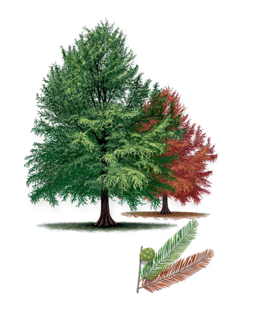
- Este conífero enano de variedad cultivada luce mejor en un proyecto de paisajismo de casa
Artwork © Robert O’Brien
- Possumhaw
-
Possumhaw (Ilex decidua)
- 12' - 20' (3. 7m - 6.1m)
- Orange-red berries throughout winter; high wildlife value
- Deciduous Caducifolio
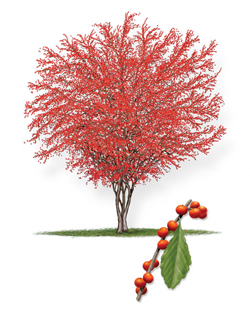
- Frutos del bosque durante todo el invierno; de gran valor para la fauna silvestre
Artwork © Robert O’Brien
- Post Oak
-
Post Oak (Quercus stellata)
- Root disturbance and overwatering can be detrimental; mature trees are majestic with large, curving branches
- Deciduous Caducifolio
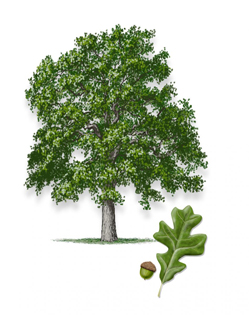
- El perturbar la raíz o regar en exceso puede ser perjudicial
- Los árboles maduros son majestuosos con ramas grandes y curvas
Artwork © Robert O’Brien
- Red Mulberry
-
Red Mulberry (Morus rubra)
- 25' - 45' (7.6m - 13.7m)
- High wildlife value; tasty fruit
- Deciduous Caducifolio
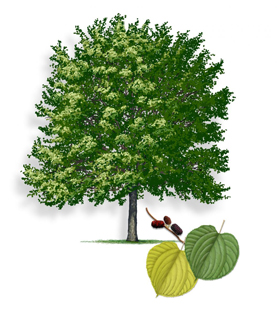
- De gran valor para la fauna silvestre
- Fruta de sabot agradable
Artwork © Robert O’Brien
- Scarlet Buckeye
-
Scarlet Buckeye (Aesculus pavia)
- 5' - 15' (1.Sm - 4.6m)
- Gorgeous large red bloom clusters in mid-spring; summer leaf drop occurs in dry cqnditions
- Deciduous Caducifolio
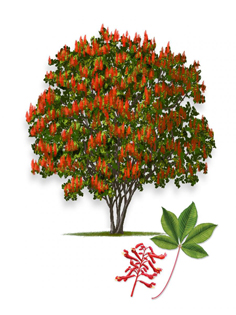
- Grupos de flores grandes de color rojo con una aparienca atractiva a mediados de la primavera
- La caída de hojas ocurre durante el verano en condiciones de sequía
Artwork © Robert O’Brien
- Texas Ash
-
Texas Ash (Fraxinus albicans)
- 30’ - 45’ (9.1m - 13.8m)
- Excellent medium sized tree for a smaller landscape with yellow fall foliage
- Deciduous Caducifolio
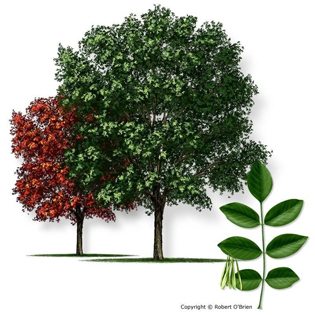
- Excelente árbol de tamaño mediano para un paisajismo pequeño con follaje amarillo durante el otoño
Artwork © Robert O’Brien
- Texas Mountain Laurel
-
Texas Mountain Laurel (Sophora secundiflora)
- 12' - 20' (3.7m - 6.1m)
- Fragrant purple grape candy scented blooms in the spring
- Evergreen Perennifolios
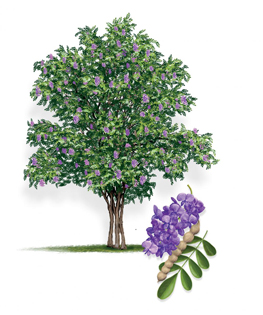
- Flores fragantes con olor a dulce de uva morada
- Crece en la primavera
Artwork © Robert O’Brien
- Texas Persimmon
-
Texas Persimmon (Diospyros texana)
- 10' - 20' (3m - 6.1m)
- Bears fruit attractive to wildlife; peeling bark reveals smooth, colorful trunks·
- Deciduous Caducifolio
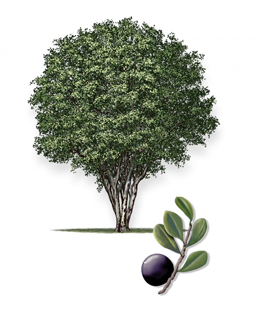
- Da una fruta que es atractiva para la vida salvaje
- Al pelar la corteza revela troncos suaves y coloridos
Artwork © Robert O’Brien
- Texas Redbud
-
Texas Redbud (Cercis canadensis var. texensis)
- 15' - 20' (4.6m - 6.1m)
- Light pink blooms early spring; more drought tolerant than eastern redbud species
- Deciduous Caducifolio
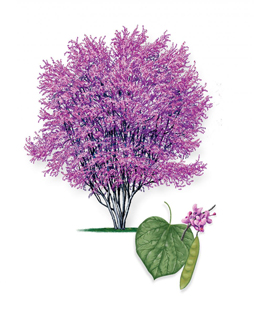
- Flores rosas claro a principios de la primavera
- Más resistente a la sequía que las especies de árboles de ciclamor de la zona este
Artwork © Robert O’Brien
- Texas Red Oak
-
Texas Red Oak (Quercus buckleyi)
- 35' - 45' (10.7m - 13.8m)
- Beautiful orange and red fall leaf coloration
- Deciduous Caducifolio
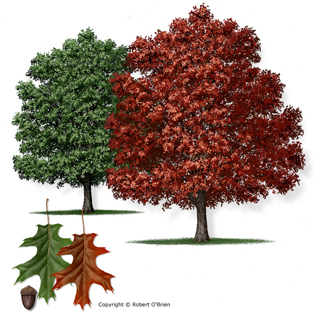
- Bella coloración de hojas naranjas y rojas durante el otoño
Artwork © Robert O’Brien
- Wafer Ash
-
Wafer Ash (Ptelea trifoliata)
- 6' - 15' (1.8m - 4.6m)
- Sweet nectar attracts many pollinators; the seed "hops" were once used for brewing beer
- Deciduous Caducifolio
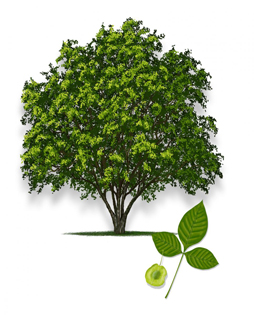
- Un néctar dulce atrae muchos polinizadores
- Los "lúpulos" de la semilla se usaron en algún momenta para la preparación de cerveza
Artwork © Robert O’Brien
- Western Soapberry
-
Western Soapberry (Sapindus saponaria var. drummondii)
- 30' - 50' (9.1m - 15.2m)
- Fruit used to make soap, adaptable to harsh conditions; has high wildlife value
- Deciduous Caducifolio
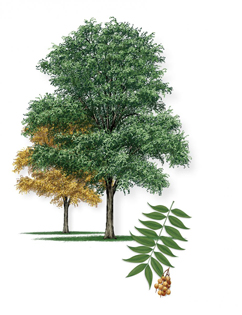
- La fruta se usa para hacer jabón, adaptable a condiciones climatológicas agresivas
- Tiene gran valor para la fauna silvestre
Artwork © Robert O’Brien
- Wright Acacia
-
Wright Acacia (Senegalia wrightii)
- 10' - 20' (3m - 6.1m)
- Most cold hardy of the Texas; acacia species; very resistant to pests and diseases
- Deciduous Caducifolio
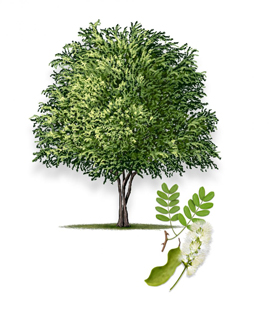
- La más resistente al frio de las especies de acacia en Texas
- Muy resistente a plagas y enfermedades
Artwork © Robert O’Brien
- Yaupon
-
Yaupon (Ilex vomitoria)
- 10'-20' (3m-6.1m)
- Popular small tree with red berries; has weeping, columnar, and dwarf forms
- Evergreen Perennifolios
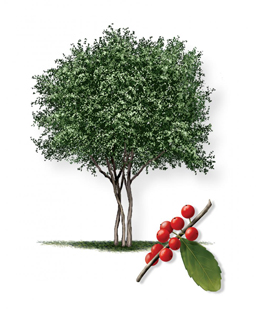
- Árbol pequeño popular con frutas del bosque rojas
- Tiene formas de ramas caídas, en columna y enanas
Artwork © Robert O’Brien

Summer 2024 Update: Our last colony of Bees swarmed and left the hive. Our volunteer Beekeepers are maintaining their home in their absence and are looking for a new colony that would like to live in this hive. "Bee" on the lookout for the return of the honeybees sometime soon.
Fascinated by the European honey bee? Check out our indoor exhibit in the Visitors Pavilion to view the inner workings of a living hive. You might even locate the queen bee herself! Bees and care provided by Austin Bees.
- Take a virtual tour of the Honey Bee Observation Hive
-

Our human sundial was created through a partnership with MathHappens, UTeach, and the Austin Parks and Recreation Department. Let your body tell the time as it plays the role of the gnomon, or the piece that casts the shadow on the blocks.
- Take a virtual tour of the Human Sundial

Take a walk around our site to learn more about our pond system. Look for basking turtles at the Upper Pond. Watch the water flow below from the bridge at the Creek. Meet curious fish at the dock of our Lower Pond.
- Take a virtual tour of the Pond
-

Are you an enthusiastic seed saver? Interested in learning about our native plants? The Seed Library is a place for the community to share and exchange seeds to grow at home. Bring in seeds you've collected to share and check out different seeds brought in by other members of the community. Learn more about how to save seeds and find other seed saving and exchanging resources HERE.
- Take a virtual tour to learn about our native plants
-

Across ANSC, native and adapted plants are placed for wildlife. Our Pollinator Gardens are home to a variety of plants that bloom throughout the year, creating ideal habitats for native pollinators.
- Take a virtual tour of our Pollinator Gardens

The Art in Public Places program (AIPP) requests proposals from visual artists to design, fabricate, and install artworks at city-owned locations around the city, including ANSC. More information about temporary exhibition of public art across Austin can be found on the AIPP website.
- Permanent Installations
-
Arboreal Passage
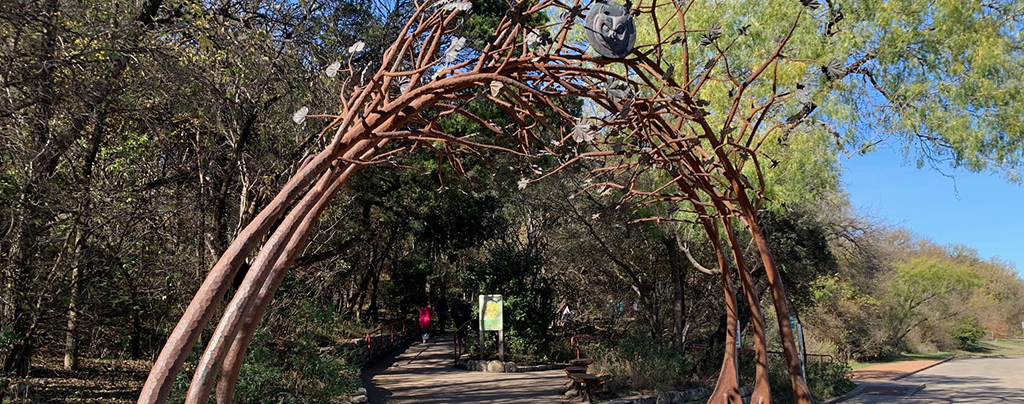
Colin McIntyre, 2011. Forged Steel, stainless steel, copper, bronze, limestone, and oak. Courtesy of Art in Public Places.
Big Snake
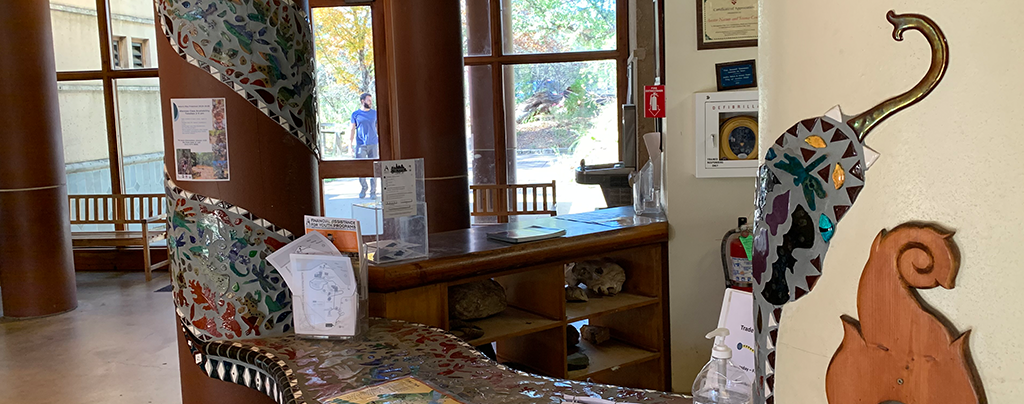
Kathleen Ash and Elena Eidelberg, 1997. Ceramic, glass, and wood. Courtesy of Art in Public Places.
Land Before Us
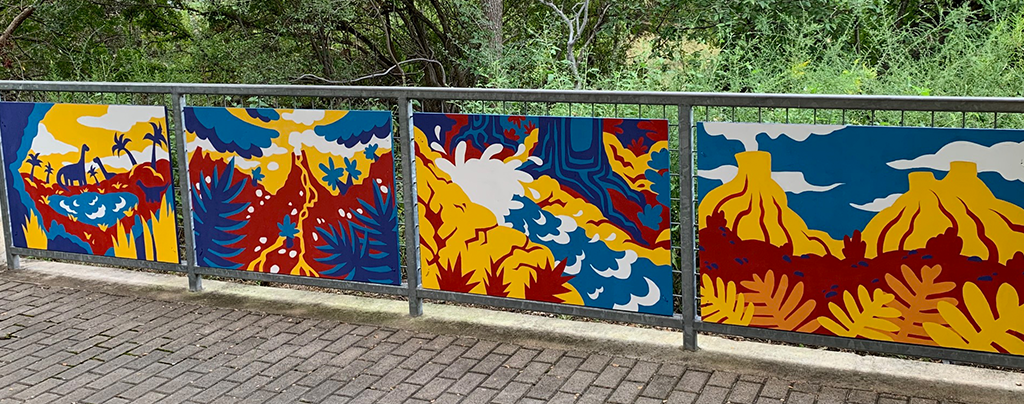
Steffany Bankenbusch, 2019. Acrylic on wood panels. Courtesy of the TEMPO 2D 2019 program.


